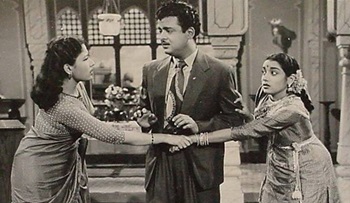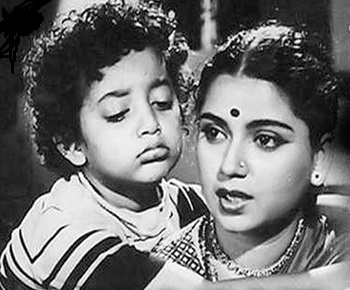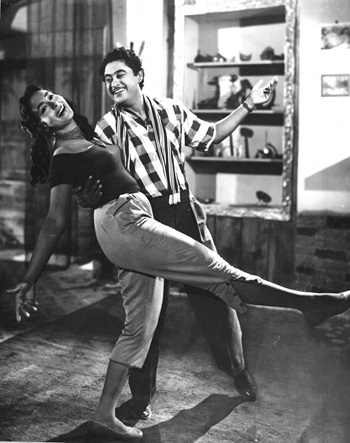Apr 14, 2025
Apr 14, 2025
The latter half of 1950s – Part 3
Apart from Chori Chori, AVM had three successful films in succession, Bhai-Bhai, Miss Mary, and Bhabhi. Directed by MV Raman, Bhai-Bhai was a family drama starring Ashok Kumar and Kishore Kumar as brothers, along with Nirupa Roy, Shyama, Nimmi, and Om Prakash. The film showed Kishore Kumar maturing as an actor. Most people remember Ae dil mujhe batade sung by Geeta Dutt from the film, but music director Madan Mohan earned fame for his classical-based composition, Qadar jani na, sung by Lata Mangeshkar. Speaking to Amin Sayani, ghazal queen Begum Akhtar recalled that when she heard Qadar jani na in Lucknow, she was so impressed that she made a trunk call to Madan Mohan in Mumbai, and she and her companions spoke to the music director for over 20 minutes, during which Madan Mohan sang the song to each of them. There were no speakerphones in those days, and trunk calls were expensive.
 Miss Mary (1957), a remake of a Telugu hit Missamma, was the first Hindi film directed by LV Prasad. Gemini Ganeshan, who had starred in the Tamil version played the lead in the Hindi version opposite Meena Kumari, with Kishore Kumar in a comedy role. Telugu film star Jamuna reprised her role from the Telugu version. The film was an adaptation of Bengali film Manmoyee Girls School (1935), based on a Bengali play of the same name by Rabindranath Maitra. Hemant Kumar provided some popular tunes like So gaya saara jahan, Yeh mard bade dilsard, and O raat ke musafir. For Brindavan ka krishna kanhaiya, Hemant Kumar adopted the tune composed by Ghantasala for the Telugu version. Kishore Kumar’s Gaana na aaya was a delightful comedy song.
Miss Mary (1957), a remake of a Telugu hit Missamma, was the first Hindi film directed by LV Prasad. Gemini Ganeshan, who had starred in the Tamil version played the lead in the Hindi version opposite Meena Kumari, with Kishore Kumar in a comedy role. Telugu film star Jamuna reprised her role from the Telugu version. The film was an adaptation of Bengali film Manmoyee Girls School (1935), based on a Bengali play of the same name by Rabindranath Maitra. Hemant Kumar provided some popular tunes like So gaya saara jahan, Yeh mard bade dilsard, and O raat ke musafir. For Brindavan ka krishna kanhaiya, Hemant Kumar adopted the tune composed by Ghantasala for the Telugu version. Kishore Kumar’s Gaana na aaya was a delightful comedy song.
 AVM’s Bhabhi, directed by the director duo Krishnan–Panju, was a family drama starring Balraj Sahni, Nanda, and Tamil actress Pandari Bai, with Chitragupt as music director. It was a remake of the Tamil film Kula Deivam, which was made from the Bengali film Bhanga Gara. With excellent performances by the leading actors, the film was a hit. Chitragupt had worked as a music director from the mid-1940s but most of his films were either mythological, historical, costume dramas, or low-rated social films. This was his first big film and he composed good songs. Chal ud ja re panchhi sung by Mohammed Rafi is one of Rafi’s best songs. But Bhabhi did not change Chitragupt’s fortunes significantly. Perhaps, he lacked the marketing strategy needed to compete with his highly talented and well-entrenched rivals.
AVM’s Bhabhi, directed by the director duo Krishnan–Panju, was a family drama starring Balraj Sahni, Nanda, and Tamil actress Pandari Bai, with Chitragupt as music director. It was a remake of the Tamil film Kula Deivam, which was made from the Bengali film Bhanga Gara. With excellent performances by the leading actors, the film was a hit. Chitragupt had worked as a music director from the mid-1940s but most of his films were either mythological, historical, costume dramas, or low-rated social films. This was his first big film and he composed good songs. Chal ud ja re panchhi sung by Mohammed Rafi is one of Rafi’s best songs. But Bhabhi did not change Chitragupt’s fortunes significantly. Perhaps, he lacked the marketing strategy needed to compete with his highly talented and well-entrenched rivals.
Mohan Sehgal’s New Delhi, starring Kishore Kumar and Vyjayantimala, was well ahead of its time, projecting inter-regional alliances. Kishore Kumar dominated the film with his acting. His songs Arre bhai nikal ke, Milte hi nazar, Nakhrewali, and Lata Mangeshkar's songs Zindagi bahar hai, and Murli bairan bhai, were hits. For the first time in Hindi films, a female dancer performed the Bhangra when Vyjayantimala danced for the songs Bari barsi khatan gaya si and Tum sang preet lagai rasiya, performing them with the same ease as her Bharatanatyam number, an Alarippu, with well-known Karnatak musician ML Vasantakumari singing in accompaniment.
Kishore Kumar and Vyjayantimala clicked as a leading pair and gave several hits. Their next hit was Asha, produced and directed by MV Raman, who had left AVM to set up his own production company. The film was a zany comedy, partly in Gevacolor and partly in Technicolor with songs, dances, and modern music composed by C Ramchandra, who earned the title of the rock-’n’-roll king of Indian cinema with Mr John Ya Baba Khan Ya Lala Roshandaan sung by Asha in Baarish (1957) and Eena meena deeka in Aasha. The words of Eena meena deeka were inspired by children playing outside C Ramchandra's music room, chanting Eeny, meeny, miny, moe. C Ramchandra’s Goan assistant John Gomes added the words Maka Naka and together they added more nonsense rhymes till they ended with Rum pum posh. Eena meena deeka became the most popular rock and roll song of the era. It was sung separately by the lead pair. Kishore Kumar danced to the exuberant composition zestfully, with very quick steps, his yodeling in the song sending viewers into a tizzy. On her part, Vyjayanthimala matched his speed, sporting a walking stick. Vyjayantimala showed her versatile talent in Chal chal re Kanhaaii chhaliya, dancing brilliantly, to the tabla accompaniment composed by C Ramchandra.
American actor Danny Kaye was UNICEF Goodwill Ambassador from 1954 to 1987. During his visit to India in 1957, in connection with UNICEF work, he heard about a Hindi movie with similarities to one of his hit films. He viewed the film and, struck by the resemblance, raised the matter with Paramount Pictures, the distributors of the film. Plagiarism was common in Hindi films. Lifting storylines, without acknowledging the source, was nothing new. Earlier, I have mentioned some Hindi films which were ostensibly inspired by English films but were plagiarized versions, Jadoo (Loves of Carmen), Shart (Strangers on a Train), Baarish (On the Waterfront), to mention a few.
Begunah, starring Kishore Kumar, Shakila and Helen, was not a scene-by-scene copy of Danny Kaye-starrer Knock on Wood (1954). IS Johar, who had written Shart earlier, wrote Begunah, making some changes but retaining the main theme. Paramount Pictures, New York filed a case along with the producers, Diana Pictures, against Mahipatrai Shah, producer of Begunah, claiming that the story of Begunah was a direct lift from Knock on Wood. The court ordered the destruction of all prints. Except for some prints that were hidden clandestinely, prints of Begunah were left in the country. Sixty years later National Film Archive of India (NFAI) retrieved a part of the film. If you search for the movie on YouTube, you get a link that says, “Begunah (1957) full movie/Kishore Kumar, Shakila, Helen”, but when you play the film, it turns out to be a Sheikh Mukhtar film of 1970. The songs from Begunah available on YouTube have no videos.
Begunah had one of Kishore Kumar’s most bizarre songs, that only Kishore could have pulled off. Aaj na jane pagal manwa kahe ko ghabraye, had a refrain ending with six hiccups, followed by a yodel. Mukesh’s Ai pyase dil bezuban, filmed on music director Jaikishan, turned out to be the singer’s comeback number. Kishore Kumar’s duet with Usha Mangeshkar Aaja raat beeti jaye was popular, and so was Din albele pyar ka mousam in which Manna Dey sang for Kishore Kumar.
Ashok Kumar and Kishore Kumar teamed up again in Satyen Bose’s Bandi (1957), along with their third brother Anup Kumar. Kishore Kumar impressed us once again with his acting prowess and left two songs tuned by Hemant Kumar, Ek roz hamari bhi dal galegi, and Chup ho ja amiron ki ye sone ki ghadi hai in our memories, indelibly.
 The three brothers gave us a rib-tickling comedy in Chalti ka naam gadi, also directed by Satyen Bose. Inspired by the Marx brothers, the film was produced by Kishore Kumar to boost the career of Anoop Kumar, who had yet to score a hit. The three brothers themselves created the script of the film and the scenes, playing out their real-life personalities. The star of the film was the 1928 model Ford car, bought by Ashok Kumar’s father which had outlived its shelf life. It was Kishore Kumar’s idea to make a funny film with the thirty-year-old inanimate family member at the centre.
The three brothers gave us a rib-tickling comedy in Chalti ka naam gadi, also directed by Satyen Bose. Inspired by the Marx brothers, the film was produced by Kishore Kumar to boost the career of Anoop Kumar, who had yet to score a hit. The three brothers themselves created the script of the film and the scenes, playing out their real-life personalities. The star of the film was the 1928 model Ford car, bought by Ashok Kumar’s father which had outlived its shelf life. It was Kishore Kumar’s idea to make a funny film with the thirty-year-old inanimate family member at the centre.
SD Burman and his son Rahul gave several hit tunes. Babu Samjho Ishaare, with the brothers riding the jalopy, named Champion in the film, was a runaway hit. Haal Kaisa Hai Janaab Ka was Kishore’s first song to top the Binaca Geetmala in 1959 and his solo Ek ladki bheegi bhaagi si was ranked high. Hum thay woh thay and Ek ladki bheegi bhaagi si were based on Tennessee Ernie Ford's The Watermelon Song and Merle Travis's Sixteen Tons respectively. When he left college, Kishore Kumar had a balance of five rupees and twelve annas in the college canteen. He used this figure in the song Main sitaron ka taraana, asking the heroine for panch rupayya barah anna.
Madhubala, who began her career as a child artist in Bombay Talkies, was a childhood playmate of Kishore Kumar. On the sets of Chalti Ka Naam Gaadi, they rekindled their friendship. Their romance blossomed during Haal kaisa hai jab ka shooting at Mahabaleshwar, in the shadow of Madhubala’s painful breakup with Dilip Kumar and Kishore Kumar's serious differences with his wife Ruma Devi.
Ruma Devi left Kishore Kumar in 1958, after eight years of marriage taking her six-year-old son Amit to Kolkata. The separation created a void in his life that he tried to remedy by spending more time in the studios. With his career graph on the rise, there was no time to languish. Several of his films were under production. His co-stars were the top heroines of the industry including Nargis, known to be very choosy about her roles. By then, Kishore Kumar was featured on the cover page of Filmfare four times. Kishore was reported to be charging more than a lac per film.
Kishore Kumar’s success had its flip side in the shape of income tax. At that time, the income tax levied on artists was often at the highest slab of 87.5 percent. The income tax department threatened him with imprisonment if he failed to meet the demand by the end of the year. Someone advised him to invest in a flop film. Kishore Kumar produced the Bengali film Lukochuri, with Mala Sinha and Anita Guha and music by Hemant Kumar. The film was a take-off on the corruption in Bombay’s film-music industry, including plagiarism. But the film celebrated a silver jubilee in Calcutta, adding further to Kishore Kumar’s income tax problems. Kishore Kumar’s next film, Chalti Ka Naam Gaadi, was produced jointly with his secretary Anoop Sharma hoping it would fail commercially but the film became a success. Kishore Kumar gave up all its rights to Anoop Sharma to avoid adding to his earnings.
 Dilli Ka Thug, produced and directed by SD Narang, and starring Kishore Kumar and Nutan, was the tenth most successful film of 1958. Narang, who had joined the film industry as a hero in 1941 with Khazanchi, a major hit of the time, produced in Lahore, suffered from the effects of Partition and shifted to Mumbai in 1951. Narang gave Kishore Kumar a free hand in Dilli Ka Thug, mostly because of his ineptness. The publicity for the film focused on a water-ballet scene, in Gevacolor, with Nutan in a swimsuit, but the viewers were impressed with Kishore Kumar’s antics as he played an innocent man on the run. The songs of Dilli Ka Thug tuned by Ravi were hummable. Kishore Kumar’s Hum to mohabbat karega was in tune with his acting in the film, as was his duet with Asha Bhonsle C-A-T cat, cat mane billi, but the soulful Kishore Kumar and Asha Bhonsle duet, Yeh raaten yeh mausam is one of Ravi's best compositions
Dilli Ka Thug, produced and directed by SD Narang, and starring Kishore Kumar and Nutan, was the tenth most successful film of 1958. Narang, who had joined the film industry as a hero in 1941 with Khazanchi, a major hit of the time, produced in Lahore, suffered from the effects of Partition and shifted to Mumbai in 1951. Narang gave Kishore Kumar a free hand in Dilli Ka Thug, mostly because of his ineptness. The publicity for the film focused on a water-ballet scene, in Gevacolor, with Nutan in a swimsuit, but the viewers were impressed with Kishore Kumar’s antics as he played an innocent man on the run. The songs of Dilli Ka Thug tuned by Ravi were hummable. Kishore Kumar’s Hum to mohabbat karega was in tune with his acting in the film, as was his duet with Asha Bhonsle C-A-T cat, cat mane billi, but the soulful Kishore Kumar and Asha Bhonsle duet, Yeh raaten yeh mausam is one of Ravi's best compositions
By 1960, Kishore Kumar had established himself as a star, with a unique niche for himself as a singing actor, dancer, and comedian, unmatched by his peers. His playback singing also gained ground with hits from Munimji, Paying Guest, and Funtoosh. At the same time, it sounded strange to hear, first Manna Dey (Begunah) and then Mohammed Rafi (Shararat and Ragini), singing playback for him.
In Begunah, Kishore Kumar refused to sing Din albele because he had an issue with the producers on the payment of his dues. When he heard that Manna Dey would sing for him, he begged Manna Dey not to record the song. Manna Dey did not oblige on the grounds of ethics. He had already committed to music director Shankar to sing the song.
According to HS Rawail, the producer of Shararat, Kishore Kumar was genuinely busy and had no time to record a song. When he could not get Kishore to the recording studio after several attempts, Rawail asked him to let Mohammed Rafi sing for him and Kishore Kumar agreed.
In Ragini, Kishore Kumar played the role of a singer. O.P. Nayyar got Man mora banwra, (to be sung on the screen by Kishore) recorded by Mohammed Rafi. Kishore Kumar was hurt by OP Nayyar’s action. “His contention was that the song was a classical one”, Kishore wrote in Filmfare, “and that I wasn’t capable of singing classical songs – I, who began my singing career with classical songs.” Nevertheless, when angry viewers raised the matter in the ‘letters to editor’ column of Filmfare, Kishore Kumar gracefully wrote to the editor, saying that he was a fan of Mohammed Rafi. Years later, in 1975, he revealed in Dharamyug, that the song was recorded in Rafi’s voice to go on Bharat Bhushan, who was the original choice for the role.
Continued to Next Page
16-Nov-2024
More by : Ramarao Annavarapu

|
Beautifully narrated sir. Most of the songs I heard over my neighbour's radio, a luxury then. For some of the songs I remember to have performed dance of the stage as a boy. I saw films like Bhai Bhai, Bhagam Bhag and Aasha. |

|
Beautifully written with a lot of passion. Your recall is excellent. How did Kishore Kumar transition to a playback superstar ten years later? |

|
Beautiful memories of a golden age, Sir! I didnt know Kishore Kumar was a childhood playmate of Madhubala, far less that he was in trouble with the income tax deptt. Thats news for me. Whatever the case, I have wistful memories of the number "Hal kaisa hai janab ka". I remember watching the movie on Doordarshan the very first time around 1987. Those were the days! Kishore was truly a great actor as well as singer. Keep the memories coming !! |

|
Sir, Thanks.eh dil mujhe bata de in Bhai Bhai had a refrain from the tune April in Portugal. |